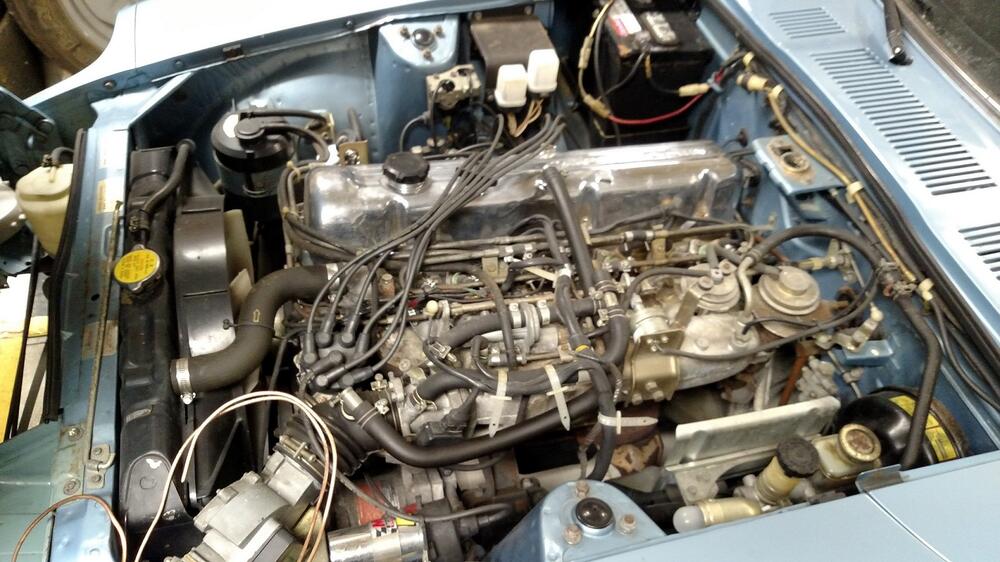Everything posted by Captain Obvious
-
Sudden engine shutoff
Whatever works.
-
How Do You Properly Run An Oil Catch Can?
Oh, and forgot to mention... Since you're trying to create a complete path that clears out the entire engine interior, that's why the two vent connections are so far apart. If they were both on the valve cover, you would set up a little circle there. And if they were both on the block, you wouldn't clean out the head area. They put one on the head and one on the block so it pulls through the entire block. On "V" style (and opposed) engines, you can put one vent on each valve cover because they are each joined to each other through the block cavity. But on the inline engines, you need one at the bottom and one at the top.
-
How Do You Properly Run An Oil Catch Can?
The top and bottom are not sealed at all. There are huge holes between top and bottom at both the front (where the timing chain lives), and the rear where the valve train oil drains back down into the oil pan. Top and bottom are in no way sealed from eachother. The point of the two vents is that you are supposed to have positive crankcase ventilation (PCV) under all operating conditions. With just one vent hole (located at either top or bottom) you could vent off the blow-by, but you would not be able to completely remove the vapors from the block. By having two vents, you can set up a circulatory path and actually refresh the air inside the crankcase with fresh clean air. This enables you to do more than just vent off the excess... It allows you to evaporate off the water vapor and more thoroughly remove any corrosive blow-by gasses.
-
How Do You Properly Run An Oil Catch Can?
Gotcha. So he's assuming you (the purchaser) will do something appropriate with that crankcase vent and NOT leave the vapors in the block. @duffymahoney
-
How Do You Properly Run An Oil Catch Can?
Newer cars have MAP sensors, AFM's, TPS sensors, and O2 sensor feedback. Using all of those tools allows them pull out of one block vent through the PCV right into the intake manifold while venting the second block vent back to the air cleaner in front of the AFM. Problem is that on our early (much more crude) EFI cars, we had only one of those input sources (the AFM)*, and we have no feedback system (O2). The whole system operates on "assumption". Assumption that everything is working as designed because the ECU module has no way to know or tell if it isn't. So if you pull from one side of the AFM without balancing it with the replenishment source being pulled from the same side of the AFM, things get out of whack. And there's no feedback source of info to account for it, and no computer to learn from it. * We do have a three position TPS, but that three position switch won't do anything to help with PCV details.
-
How Do You Properly Run An Oil Catch Can?
When you say he provides engines without them (the block breather tube) in place... Are you saying that his engines (as delivered) just have the breather hole hanging open with no tube installed, or are you saying that he actually blocks off the hole with a plug of some sort?
-
What is this support bracket in the hatch just above the button?
I don't know what year they started putting that support bracket in, but I can tell you it was present on my 3/74 small bumper 260.
-
How Do You Properly Run An Oil Catch Can?
I've run into the same thing and I was planning to use the green loctite sleeve retainer. Haven't tried it yet, but I have high hopes for that. And I agree that it's weird that the original pipe was in there so firmly, but pretty much shows no retention at all when pushed back in once it was pulled out. As for the PCV and catch can thing... With the EFI, things get a little more complicated. You need to either vent everything upstream of the AFM, or vent everything downstream of the AFM. But don't mix the two. Or vent everything completely separate from the EFI system. In theory, PCV systems change direction depending on the engine RPM and load. So the whole notion of "inlet" and "outlet" is a little troubling for me. At low load (low blow-by), high intake manifold conditions, the flow goes one way. But at high load conditions when the blow-by is higher and the intake manifold vacuum is pretty much non-existent, theory says that the flow direction reverses. I guess the "normal" direction is pulled out the large pipe in the crankcase, through the PCV valve, and into the intake manifold. So if I had an "inlet" and an "outlet", I would connect the inlet to the big pipe on the crankcase and the outlet to the valve cover.
-
Steering Rack Disassembly and Refurb
My thoughts (for what they're worth): There are those that say machining the sintered oil impregnated stuff can be problematic. Unless you do it right, you can "smear" some of the material and close off the oil holes. That said, if you're only machining the OD, then that shouldn't matter. Also, SAE 841 is softer than the traditional "bearing bronze (932 or 660 leaded)". It's probably going to be softer than the original bushing, but for the steering rack application, it's probably good enough. As for the second choice from McMaster, I like that it's made from 932, and I like the oil groove. But if you cut 20mm off, you'll be cutting right through the middle of the oil groove. Now since we're using thixotropic grease and not oil... Does it really matter? And as you mentioned... I think a lot of this will all come down to how you like the fit on the ID. Good luck with the lathe work and keep us posted!!
-
Filter Bypass Valve
I haven't personally vetted the details in the below, but here's a thread in which some people actually mounted pressure sensors before and after oil filters and measured the differential pressure across filters. https://bobistheoilguy.com/forums/threads/oil-filter-pressure-differential-testing-psid.341925/ I didn't study it thoroughly, but a quick skim seems to support the theory that the delta-P over the filter media on any clean filter is very low and not enough to open the bypass valve. And that delta-P is pretty much unaffected by oil temp and only goes up as the filter becomes dirty.
-
Filter Bypass Valve
I should have expected that. Unfortunately I couldn't find any details about the internals of the Nissan stock filter. Not surprising, but unfortunate. So I don't know if Nissan included a bypass valve inside their filters or not. The advantage of putting a bypass in the filter is you can use it in applications whether there is a bypass built into the block or not. The disadvantage of putting a bypass in the filter is it takes up space which could otherwise be used by filter media. In other words, you can have more filter in the filter if you don't have to put a bypass valve inside. So if your're positive that the application where you are putting the filter has a bypass valve elsewhere, you don't have to burn that space with at valve inside the filter. And since Nissan designed both sides of that equation, I don't know what they did. But if you want to send me one, I would be happy to cut one open for you. And still... The claim that if you change your oil and filter at reasonable intervals and never let it on there so long that it clogs up the filter, it doesn't really matter.
-
Filter Bypass Valve
Don't make me come down there to make sure that happens.
-
Filter Bypass Valve
What filter are you running? I'll see if I can dig up details on the internals. And by the way... In theory, the filter bypass only ever comes into play if you let the filter get so dirty that it clogs up the filter media. I know you're going to be changing your oil on your nice new motor way frequently enough that's not going to be an issue.
-
ZCON 2021 Roll Call
Bummer. It's back? Or it never left completely?
-
Filter Bypass Valve
Pretty much all of the new filters these days include a bypass valve built into them. You might not need that bypass in the block at all?
-
Plug wiring for distributor 1974 260z
If both the pickups are moved by the vacuum advance plate, then it really doesn't matter which one he uses. Just set the timing with a light and everything else should come out in the wash, right? The two pickups never change with respect to eachother. They're a fixed delta under all conditions.
-
Sudden engine shutoff
Right. On paper, that's not it. Of course, however... There is still the possibility that it's intermittent, and it was 740 Ohms that instant with the wires in exactly that position when you measured it. Aren't I just the bluebird of optimism?
-
Sudden engine shutoff
You can certainly measure the resistance of the pickup coil. I assume (but haven't looked) that there is a spec in the FSM to compare it against. But I'm thinking that if there is enough heat up there to cook the insulation on the wires, that just wrapping them with tape wouldn't change much. You would just start cooking the tape instead of cooking the wires. Bottom line? I think it might be a red herring, but I'd keep a close eye (and nose) on it. There should never be a hot electronics smell in the engine compartment. I know exactly the smell you're talking about, and that should not be happening.
-
Air Regultor connections (77 280z Auto)
They changed the PCV routing scheme for 78 and the word on the street is that dealers would upgrade the PCV system of the previous years to the later (78) design whenever a car came in for servicing. The 78 PCV design included a "capped off T" on the rubber duct between the AFM and the throttle body, so from your description, it sounds like your car has the 78 style hose routing. So for your PCV system, you should refer to the 78 FSM instead of the 77. Here's a pic of a 78 scheme:
-
COVID-19
<Sigh...> So is the Lambda covered well by the current vaccines? I know it's just a matter of time before this thing uses the unprotected pool of donors to mutate into a form that is NOT picked up by the vaccine, but I'm hoping that hasn't happened yet.
-
280z master fuse list?
Thanks Dan!
-
COVID-19
Of course your health care is your personal choice, but one of the points I've been trying to make previously is that the info you get in order to make your choice should come from reputable sources. If you're getting your vaccine guidance from some guy on the internet (like that fear mongering youtube video), then I think you should seek more reputable guidance. If you're getting your vaccine advice from a Facebook friend, then I think you should seek more reputable guidance. Call your doctor and ask them. Simple as that. Ask your doctor what they think. Ask them about the risks of getting a vaccine and the risks of not getting it. Ask them if they recommend getting it or not. Ask your doctor about the bad things you've heard like tracking chips and sterility. Ask them what they think about those risks. Don't listen to me. Don't listen to Facebook. Don't listen to Youtube. Don't listen to MSNBC. Don't listen to FOX. Don't listen to that wacky "news" site run by the religious cult from China. Don't listen to internet "news" from someone who calls themselves "the first port of call for the argumentative Indian." Call your doctor. YOUR doctor. Call your doctor and ask. Call them and use their guidance to form an opinion that isn't fed to you by some guy on the internet. I've been struggling with figuring out how to put that into words.
-
Wiper Mechanical Failure
Sage words from a wise man.
-
COVID-19
Yes, of course health is a personal decision. But my Z car friends won't catch your anal sex by standing next to you in line at Starbucks. In fact, by standing next to you in Starbucks, here's a partial list of things they won't catch from you: Your cancer. Your drug addiction. Your heart disease. Your obesity. Your diabetes. Lots and lots of people die from those, but the difference is YOU can't take me or my friends down with yours. And not only that, there isn't a vaccine to help prevent any of those. If we had a vaccine to reduce diabetes, I think it would be very popular and I don't think people would be diving for different corners because of it. I think I put my thoughts on the matter into reasonably good words earlier: https://www.classiczcars.com/forums/topic/63698-covid-19/?page=67&tab=comments#comment-621155
-
ZCON 2021 Roll Call
Big ol' bummer about that...









